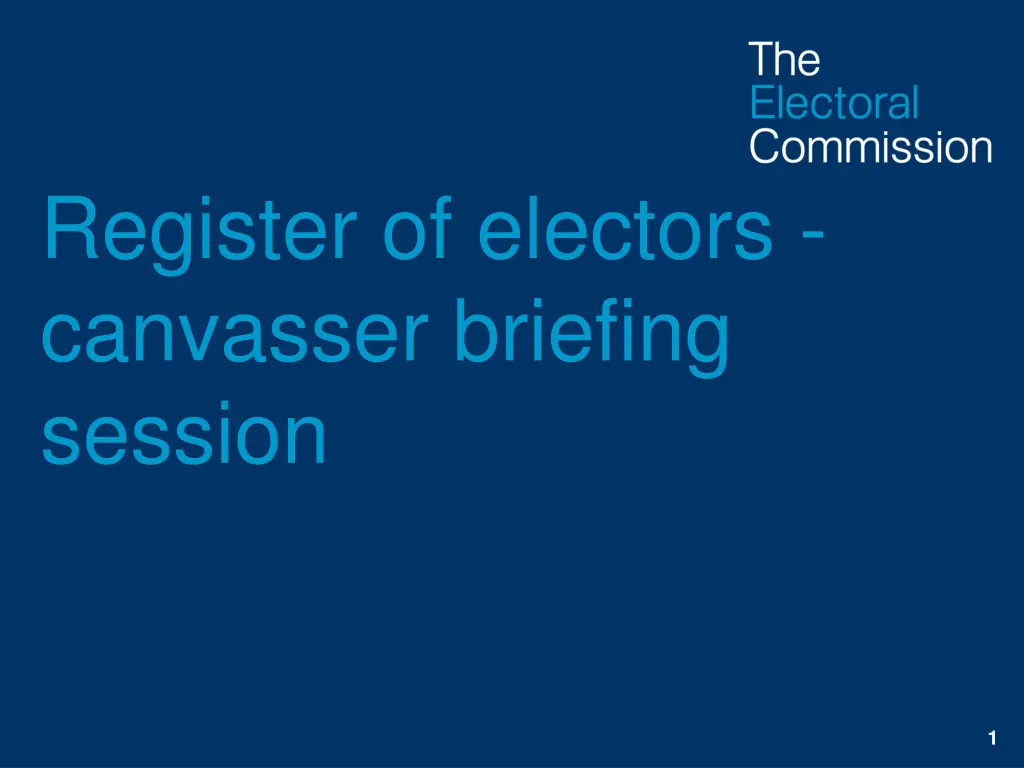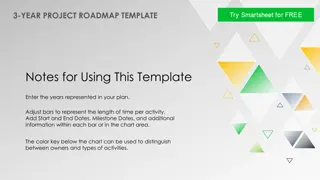
Canvasser Briefing and Electoral Registration Overview
This briefing provides canvassers with insights into their duties, the canvassing process, and legal requirements for electoral registration. Learn about eligibility criteria, application methods, and the importance of households responding to the canvass to ensure accurate voter registrations.
Download Presentation

Please find below an Image/Link to download the presentation.
The content on the website is provided AS IS for your information and personal use only. It may not be sold, licensed, or shared on other websites without obtaining consent from the author. If you encounter any issues during the download, it is possible that the publisher has removed the file from their server.
You are allowed to download the files provided on this website for personal or commercial use, subject to the condition that they are used lawfully. All files are the property of their respective owners.
The content on the website is provided AS IS for your information and personal use only. It may not be sold, licensed, or shared on other websites without obtaining consent from the author.
E N D
Presentation Transcript
Register of electors - canvasser briefing session 1
Introduction Add names of trainers 2
To outline your duties as a canvasser Objectives of the training session To ensure that you are confident about all aspects of your role 3
Resident in [add registration area] Aged 16 or over Eligibility to register And either: A British, Irish, qualifying EU citizen, EU citizen with retained rights, or a Commonwealth citizen who has permission to remain in the UK or who does not require permission to remain 5
Applicants can apply to register online by phone [if offered] / in person [if offered] All applicants must be verified their National Insurance number and date of birth are checked against official records Electoral registration 6
Legal requirement to conduct the canvass and for certain households to respond A canvass communication must be sent to every address where the ERO thinks there is a change(s) No response = follow up, choice of method Still no response = visit by canvasser New potential electors cannot register via a canvass communication Households must respond to the canvass, even if residents have made a successful application to register online. The annual canvass 7
An Invitation to Register (ITR) must be sent to any potential electors (including those whose names are added to a canvass communication) with a registration form. Prescribed reminder process The annual canvass 8
Your role is important. Key canvasser activities [Delivery of forms and reminders] Visit households/individuals that have not responded to a canvass communication or ITR to encourage a response: obtain a correctly completed form if no answer - return at a later time/date if still no answer - leave form and envelope at the property and mark your canvass list accordingly record date and time of all visits 10
The Canvass Form (CF) 11
Purpose: In order to know who is eligible to register to vote, we need to know who lives at an address. The CF is used to collect this information. Two versions: Pre-Printed with the details of all electors registered at the household Blank for properties with no electors currently registered, and any new properties you identify The canvass form 12
Example CCA 15
[Insert screenshot if offered] Online return of the CF 18
[To be included if you are providing canvassers with electronic equipment to complete and submit canvass returns directly to cover, for example: How should the equipment be operated? How to log in and keep passwords secure? What are your policies on canvassers using the equipment for other purposes?] Using tablets / smartphones to collect information and submit a canvass return 19
Key messages when following up with canvass non- responders It is important that this form is completed and returned. In order to know who is eligible to register to vote, we need to know who lives at your address. This form is to collect this information. Returning the information requested is straightforward. I have a form which I can help you complete now, or I can come back later to pick it up. [add any online response options] 20
Address Pre-printed with address details in most cases Make any corrections to the address if advised to you by a member of the household If you have to use a completely blank form (e.g. if you have identified a new property) please fill in address, including the code for that particular polling district. Information required 21
Names Make sure any pre-printed names are correct, and cross out or amend any that are incorrect Add any names as appropriate Information required Nationality If pre-printed, check the nationality is correct. If the nationality field is blank, ask what is your nationality ? 22
Other information postal / proxy vote open register see instructions on changing opt-out preference Information required Contact details (e-mail / telephone) Collect these if possible they will help us contact electors quickly in case of further queries. 23
Information required 16 and 17 year olds Always ask if there are any 16 or 17 year- olds living at the property, and ensure they are included on the form 24
Information required Nobody eligible to vote? Section for recording the reason Examples: property obviously empty business premises second home ineligible nationality in England (i.e. foreign nationals other than European Union or qualifying Commonwealth citizens) give nationality 25
Information required Declaration and signature The form must be signed by the person supplying the information DO NOT sign on behalf of the occupier; you can only sign a form where the property is clearly empty or does not exist 26
New properties You can play an important role in identifying new properties If a new property (or conversion) is identified and it is not on your list, obtain a completed Canvass Form from that property and update your list with the new property information 27
Invitations to register and the registration form 28
Who will receive an invitation to register? Potential new electors identified through, for example, the Canvass Form, your personal visit or local data. 29
Key messages when delivering the first ITR 31
Key messages when delivering ITRs during the reminder stage, speaking to non-responders Registering to vote is straightforward it only takes a few minutes, but you will need your National Insurance Number. I have a form with me which I can help you complete now, or I can come back later to pick it up. 32
Name Make sure that you are speaking to the individual named on the form and that any pre-printed name is correct; applicant to make any changes where necessary Information required Address Applicant to check pre-printed address is accurate and make corrections if necessary The applicant should also indicate whether they live at another address 33
Change of name / recently moved Their previous name if it has changed Their previous address if they have moved in the last 12 months Information required Other personal information Date of birth Nationality National Insurance number Or reasons these cannot be provided 34
Contact details Not required, but very useful if we need to make contact about their registration Other information Whether they want to be included in the open register Whether they wish to apply for a postal or proxy vote Declaration The form must include a declaration of truth made by the applicant. Information required 35
[To be included if you are providing canvassers with electronic equipment to complete and submit applications directly via the https://www.gov.uk/register-to-vote website - to cover, for example: How should the equipment be operated? How to log in and keep passwords secure? What are your policies on canvassers using the equipment for other purposes?] Using tablets / smartphones to collect identifiers and submit an application 36
Give a blank form and encourage the person to apply, explaining the various methods for registering available. If not collecting the completed application on the doorstep, make a note of: their name email address (if they have one) the date the potential new elector has been identified If you identify a new potential elector not on your list 37
Lone working We have a responsibility for your safety Assess risks when visiting locations Let someone know where you are going and what time you expect to be home Take mobile phone 39
Minimising risk NEVERgo into anyone s house Take care when carrying and lifting large quantities of forms Walk away from verbal abuse or aggression Beware of dogs and other animals Keep any electronic equipment and other valuables secure Report any incidents to your Ward Supervisor / the office 40
Responsible for forms and personal information in your care Personal data must be kept safe from unauthorised access, accidental loss or destruction. Instances of unauthorised access, loss or destruction must be immediately communicated to your supervisor. Security of personal information 42
[Cover local security measures, e.g. use of lockable cases / satchels for carrying forms don t carry more forms than you can fit into the secure case/satchel, etc.]. [Completed forms must be delivered to the office by X, within X hours/days]. [If providing canvassers with a smartphone or tablet to access https://www.gov.uk/register-to-vote: the application must be submitted directly and not stored on the device] Security of personal information 43
Always wear and show your official identification to the elector Collecting personal data on the doorstep Be aware of other people around you and take precautions so that nobody else can overhear any personal information you are collecting 44
When collecting information on a CF, make sure you are speaking to a member of the household (or landlord) When collecting information on an ITR, make sure you are speaking to the relevant individual Collecting personal data on the doorstep Not there? Do not share personal information, even with spouses or family members 45
Contacts 47
Between xpm and xpm on weekdays and xam and xpm Saturday/Sunday there will be a contact number available for queries. [01234 567890] This number will be staffed by office staff; we advise that you restrict your working hours to match these Members of the public can also call this number to check that you are working on behalf of the ERO Out of hours contacts 48
Please note your area supervisor Canvass area 1-4 Contact John Smith 01234 567891 Canvass area 5-8 Contact Jack Brown 01234 567892 Canvass area 9-13 Contact Jane Black 01234 567893 These people are your first contact in case of query and they be will contacting you during the canvass period to check your progress Area supervisors 49
Questions ? 50






















